Master the Development of Sustainable Architectural ConceptS
START IN OCTOBER 7th
The importance of green buildings cannot be overstated in today’s world as we face challenges such as climate change and resource depletion.
Green building is a design and construction approach that aims to minimize the environmental impact of buildings and improve their energy efficiency, water efficiency, and indoor environmental quality.
By adopting green building practices, we can create more sustainable and livable environments that support the transition to a low-carbon future.
In this article, we will explore some of the critical green building trends for the coming years, including an increased focus on sustainability and resilience, the use of renewable energy sources, energy-efficient design, water conservation, the use of green roofs and walls, the use of sustainable materials, net-zero energy buildings, zero-waste buildings, intelligent buildings, and retrofits and renovations of existing structures.
If you are interested in learning more about these trends and how you can incorporate them into your building projects, we invite you to read on.
Green Building Trend #1: Increased focus on sustainability and resilience
An increased focus on sustainability and resilience in building design means that buildings will be designed and constructed in a way that is more environmentally friendly and that is better able to withstand and adapt to environmental challenges, such as climate change and natural disasters.
This could involve a variety of measures, such as:
- Using energy-efficient design: Buildings designed to be more energy-efficient use less energy to operate, reducing their carbon footprint and saving energy costs. Energy-efficient design can involve insulation, efficient heating and cooling systems, and other measures to reduce energy consumption.
- Using renewable energy sources: Buildings that use renewable energy sources, such as solar or wind power, can reduce their reliance on fossil fuels and lower their carbon emissions. This could involve the use of photovoltaic panels or small-scale wind turbines.
- Designing for water conservation: Buildings that use water efficiently and minimize waste can help to reduce the strain on water resources, particularly in areas where water scarcity is a concern. This could involve the use of low-flow plumbing fixtures and greywater systems.
- Using sustainable materials: Buildings that utilize sustainable materials, such as recycled or rapidly renewable materials, can reduce their environmental impact and support the use of more environmentally friendly products.
- Designing for resilience: Buildings that are designed to be more resilient to natural disasters and other environmental challenges, such as floods, hurricanes, and earthquakes, can help to reduce damage and disruption caused by these events. This could involve using more robust and durable building materials and design features such as green roofs and walls, which can absorb stormwater and protect against wind and rain.
Overall, the goal of increasing sustainability and resilience in building design is to create more durable, efficient, and adaptable structures that can help mitigate the impacts of climate change.
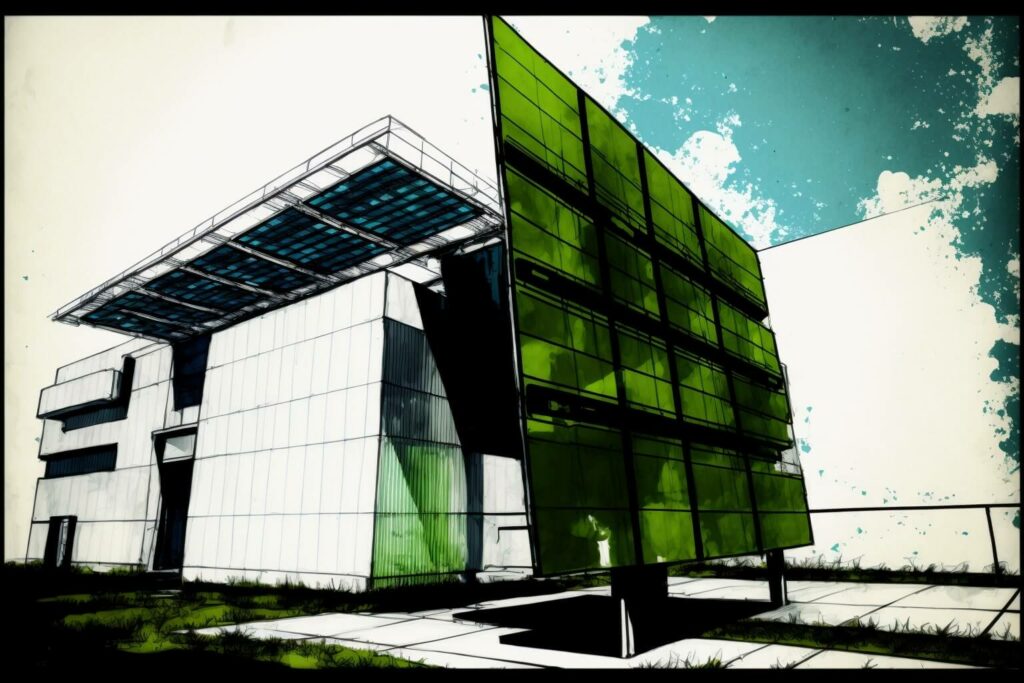
Green Building Trend #2: Use of renewable energy sources
Using renewable energy sources in building design refers to incorporating technologies that generate electricity or heat from natural, renewable sources such as the sun, wind, or water. The goal of using renewable energy sources is to reduce a building’s reliance on fossil fuels, which contribute to climate change and air pollution, and to lower the building’s carbon footprint.
Some common examples of renewable energy sources that may be used in building design include:
- Solar energy: Photovoltaic (PV) panels can be installed on the roof or walls of a building to generate electricity from the sun’s energy. In addition, solar thermal systems can be used to heat water or provide space heating.
- Wind energy: Small-scale wind turbines can be installed on the roof or a separate structure to generate electricity from the wind.
- Hydroelectric power: Buildings located near a water source, such as a river or stream, may be able to generate electricity using a small hydroelectric power system.
- Geothermal energy: Geothermal systems use heat from the earth to provide heating and to cool a building. They can be more energy-efficient and have a smaller carbon footprint than traditional HVAC systems.
Using renewable energy sources can help reduce a building’s energy costs and reliance on fossil fuels and contribute to a more sustainable and environmentally friendly built environment.
Green Building Trend #3: Energy-efficient design
The energy-efficient design uses strategies and technologies to design and construct a building to reduce energy consumption and carbon emissions.
This can involve a variety of measures, such as:
- Insulation: Proper insulation can help to keep a building warm in the winter and cool in the summer, reducing the need for heating and cooling systems.
- Efficient heating and cooling systems: Using high-efficiency heating and cooling systems, such as air source heat pumps or geothermal systems, can reduce the energy needed to maintain comfortable temperatures in a building.
- Energy-efficient lighting: Using energy-efficient lighting, such as LED bulbs, can significantly reduce a building’s energy consumption.
- Energy-efficient appliances and equipment: Using Energy Star-certified appliances and equipment, designed to be more energy-efficient than standard models, can also help reduce a building’s energy use.
- Passive design strategies: Passive design strategies, such as proper orientation, window placement, and the use of thermal mass, can help to reduce a building’s energy needs by taking advantage of natural heating and cooling processes.
Overall, the energy-efficient design aims to create buildings that use less energy to operate, reducing their carbon emissions and saving money on energy costs.

Master the Development of Sustainable Architectural ConceptS
START IN OCTOBER 7th
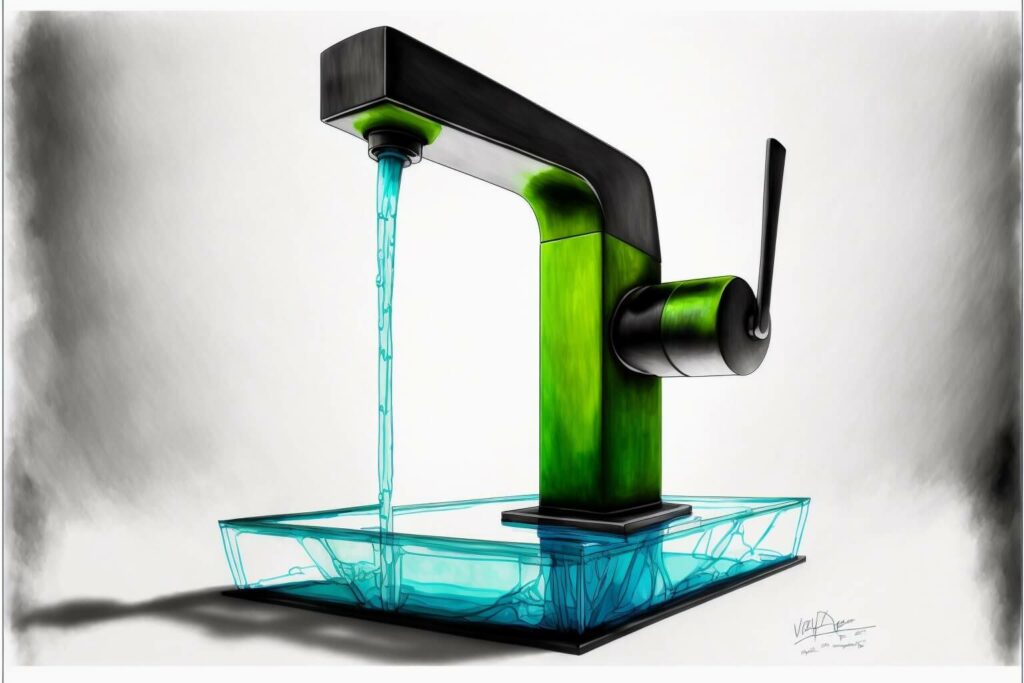
Green Building Trend #4: Water conservation
Water conservation in building design refers to using strategies and technologies to minimize water use and reduce waste in a building. This is becoming increasingly important as water scarcity becomes a growing concern in many parts of the world.
Some examples of water conservation measures that may be used in building design include:
- Low-flow plumbing fixtures: Low-flow plumbing fixtures, such as toilets, faucets, and showerheads, can significantly reduce the amount of water used in a building.
- Greywater systems: Greywater systems recycle water from sinks, showers, and laundry machines for non-potable uses such as irrigation or toilet flushing. This can help to reduce the amount of freshwater needed in a building.
- Rainwater harvesting: Rainwater harvesting systems capture and store rainwater for reuse, such as for irrigation or flushing toilets. This can help to reduce the demand for treated water and reduce stormwater runoff.
- Water-efficient landscaping: Using drought-resistant plants and implementing efficient irrigation systems can help to reduce the amount of water needed for landscaping.
Overall, the goal of water conservation in building design is to use water efficiently and minimize waste to reduce the strain on water resources and support more sustainable use of this vital resource.
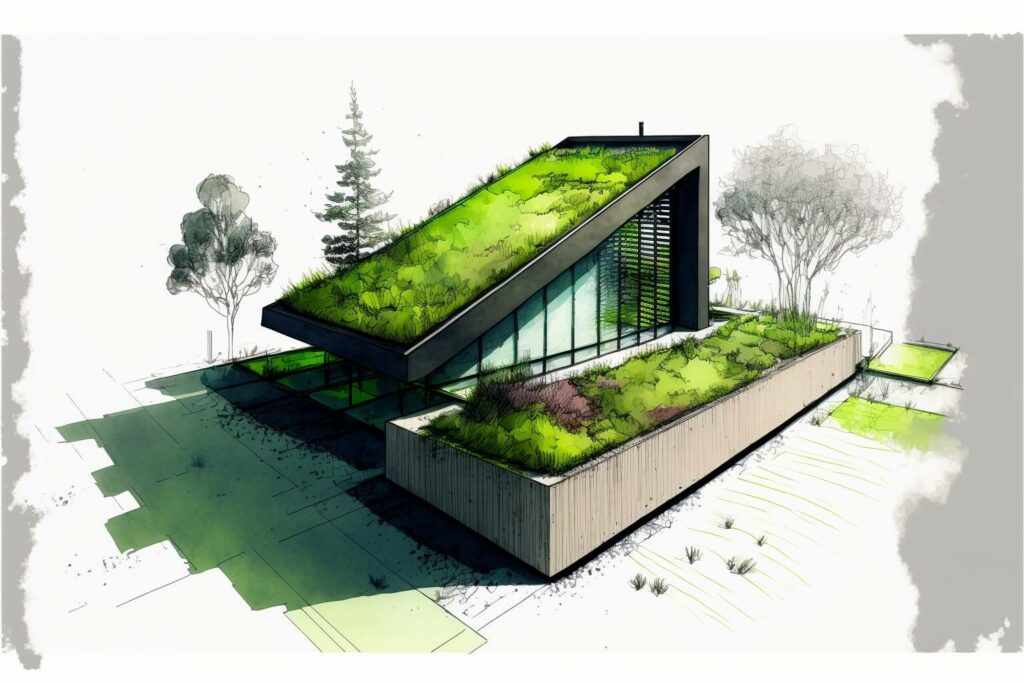
Green Building Trend #5: Green roofs and walls
Green roofs and walls are elements covered with plants and vegetation.
They can provide several environmental, social, and economic benefits, such as:
- Regulating building temperatures: Green roofs and walls can help to insulate a building, keeping it more relaxed in the summer and warmer in the winter. This can reduce the energy needed for heating and cooling and improve indoor comfort.
- Reducing stormwater runoff: Green roofs and walls can absorb rainwater and reduce the amount of stormwater that flows into municipal systems. This can help to prevent flooding and reduce the strain on stormwater infrastructure.
- Improving air quality: Green roofs and wall plants can absorb pollutants and produce oxygen, improving air quality in the surrounding area.
- Providing habitat for wildlife: Green roofs and walls can provide habitat for birds, insects, and other wildlife, which can help to support biodiversity in urban areas.
- Adding beauty to the built environment: Green roofs and walls can add visual interest and beauty to a building and provide outdoor space for people to enjoy.
Overall, green roofs and walls can contribute to a more sustainable and livable built environment and provide various environmental, social, and economic benefits.
Green Building Trend #6: Use of sustainable materials
Using sustainable materials in building design refers to incorporating environmentally friendly and sustainably sourced materials. The goal of using sustainable materials is to reduce building construction’s environmental impact and support the use of more environmentally friendly products.
Some examples of sustainable materials that may be used in building design include:
- Recycled materials: Using recycled materials, such as recycled steel, aluminum, or concrete, can help to reduce the demand for new materials and decrease the environmental impacts of extraction and processing.
- Rapidly renewable materials: Rapidly renewable materials, such as bamboo or straw, can be used as an alternative to traditional building materials. These materials can be grown and harvested more quickly than conventional materials, such as wood, and have a smaller environmental footprint.
- Low-impact materials: Some materials, such as low-VOC (volatile organic compound) paints and finishes, can have a lower environmental impact than traditional materials.
- Reusable and repairable materials: Using materials that can be easily reused or repaired can help to extend their lifespan and reduce waste.
Overall, using sustainable materials in building design can contribute to a more environmentally friendly and sustainable built environment.

Master the Development of Sustainable Architectural ConceptS
START IN OCTOBER 7th
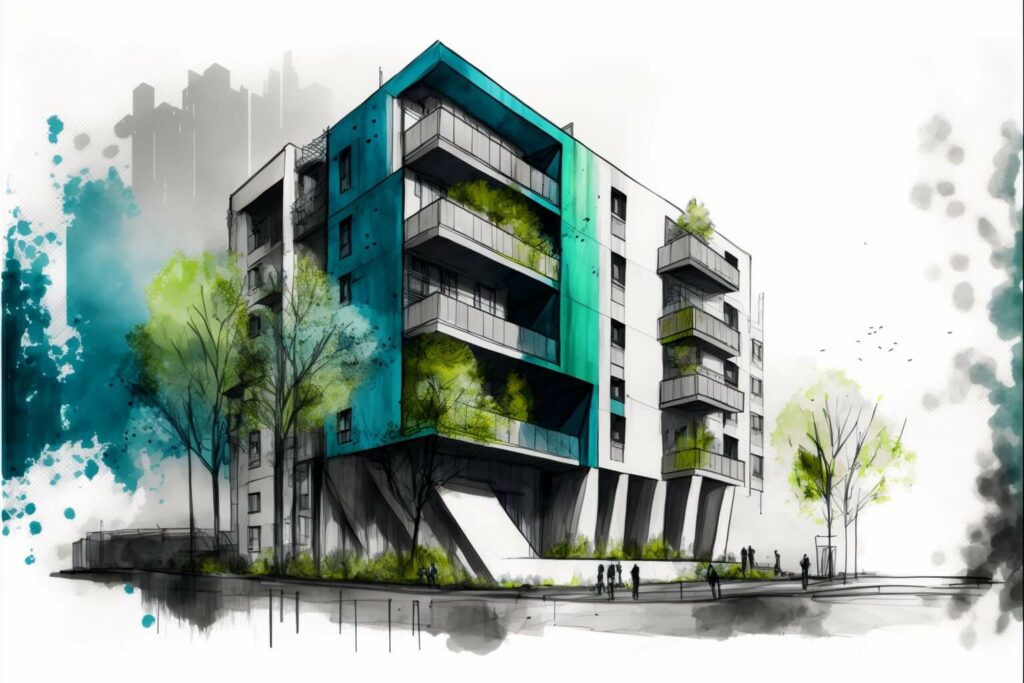
Green Building Trend #7: Net-zero energy buildings
Net-zero energy buildings are designed to produce as much energy as they consume over a year. This can be achieved using on-site renewable energy sources, such as solar panels or wind turbines, or purchasing renewable energy credits.
Net-zero energy buildings aim to reduce or eliminate a building’s reliance on fossil fuels and lower its carbon emissions.
To achieve net-zero energy status, a building must be designed and constructed to be highly energy-efficient, with features such as insulation, efficient heating, and cooling systems, and energy-efficient appliances and lighting.
In addition, the building must have sufficient renewable energy generation capacity to meet its energy needs. This may involve using on-site renewable energy systems, such as photovoltaic panels or small-scale wind turbines, or purchasing renewable energy credits to offset the building’s energy use.
Net-zero energy buildings can provide various environmental and economic benefits, including reduced energy costs and a smaller carbon footprint. They can also serve as a model for more sustainable building design and contribute to a low-carbon future.
Green Building Trend #8: Zero-waste buildings
Zero-waste buildings are designed to minimize the amount of waste generated and maximize the use of recycled materials. Zero-waste facilities aim to reduce waste’s environmental impact and support more sustainable resource use.
Some examples of strategies that may be used to achieve zero waste in buildings include:
- Reducing the amount of waste generated can involve using reusable products instead of disposable ones and designing systems and processes to minimize waste. For example, a building might use refillable water bottles instead of single-use plastic bottles or composting systems to reduce the amount of food waste generated.
- Maximizing the use of recycled materials: Building materials made from recycled materials, such as recycled steel or recycled concrete, can help reduce the demand for new materials and decrease the environmental impacts of extraction and processing.
- Implementing recycling systems: Building recycling systems, such as bins for paper, plastic, and other recyclables, can help to increase the recycling rate in a building.
- Donating or reusing materials: Instead of sending materials to the landfill, buildings may donate or reuse items no longer needed, such as office furniture or building materials.
Overall, the goal of zero-waste buildings is to minimize waste and maximize the use of recycled materials to support more sustainable resource use and reduce the environmental impact of waste.
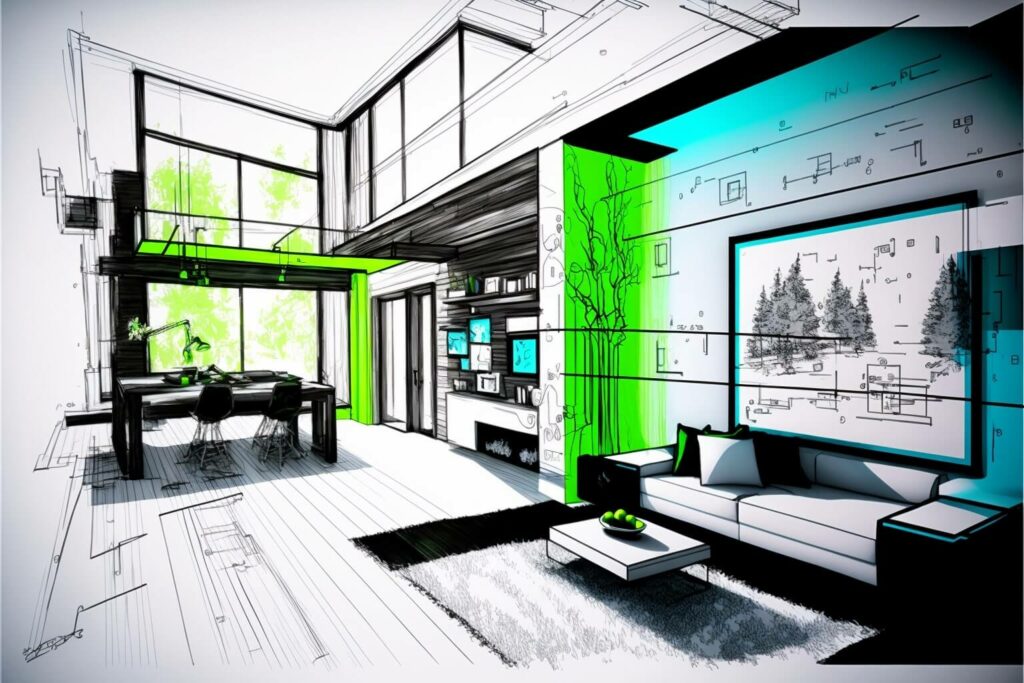
Green Building Trend #9: Smart buildings
Intelligent buildings are designed to optimize building performance and reduce energy use through smart technology, such as building management systems (BMS). A BMS is a computer-based system that monitors and controls a building’s mechanical and electrical systems, such as heating, ventilation, air conditioning (HVAC), lighting, and security.
A BMS can help to optimize building performance by:
- Monitoring and controlling energy use: A BMS can monitor energy use in real-time and adjust systems accordingly to reduce energy waste. For example, it might turn off lights in unoccupied rooms or adjust the temperature in a building to minimize heating or cooling demand.
- Providing real-time data: A BMS can provide real-time data on a building’s energy use, allowing building managers to identify areas for improvement and optimize performance.
- Automating tasks: A BMS can automate tasks such as turning off lights or adjusting the temperature, which can help to reduce energy use and improve building efficiency.
- Providing alerts and notifications: A BMS can provide alerts and notifications for issues such as equipment failures or energy use anomalies, which can help to identify and address problems quickly.
Overall, the goal of smart buildings is to optimize building performance and reduce energy use through intelligent technology. This can help to reduce energy costs, improve building efficiency, and reduce the environmental impact of buildings.
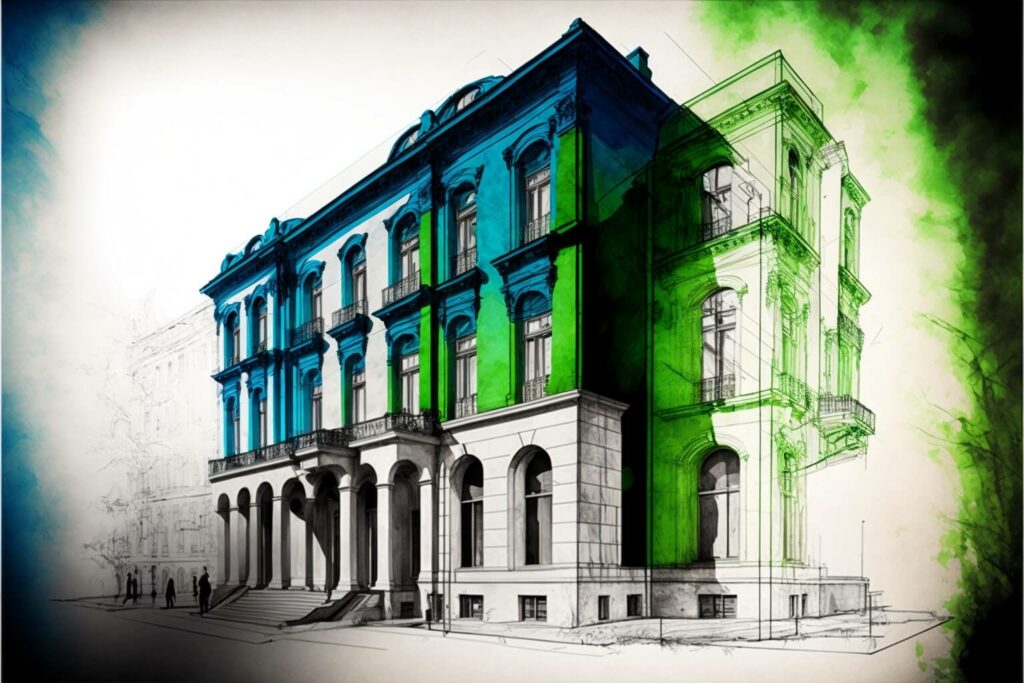
Green Building Trend #10: Retrofits and renovations
Retrofits and renovations are upgrades or modifications to existing buildings to improve their performance and make them more sustainable.
Retrofits and renovations may involve a variety of measures, such as:
- Energy-efficient upgrades: Retrofits and renovations may involve the installation of energy-efficient systems, such as heating and cooling systems, lighting, and appliances, which can help to reduce energy use and lower energy costs.
- Sustainable materials: Retrofits and renovations may involve using sustainable materials, such as recycled or rapidly renewable materials, which can reduce the environmental impact of building construction.
- Water conservation measures: Retrofits and renovations may include the installation of low-flow plumbing fixtures and greywater systems, which can help to reduce water use and minimize waste.
- Green features: Retrofits and renovations may involve adding green features, such as green roofs and walls, rainwater harvesting systems, and solar panels, which can improve the sustainability of a building.
Overall, retrofits and renovations aim to improve the performance and sustainability of existing buildings and reduce their environmental impact. As more people become aware of the benefits of green building, there may be an increase in the number of buildings retrofitted or renovated to be more sustainable.
Conclusion
As awareness of the environmental impacts of buildings grows, there is likely to be an increased focus on designing and constructing more sustainable and resilient structures.
Some of the critical green building trends for the coming years include an increased focus on sustainability and resilience, the use of renewable energy sources, energy-efficient design, water conservation, the use of green roofs and walls, the use of sustainable materials, net-zero energy buildings, zero-waste buildings, intelligent buildings, and retrofits and renovations of existing structures.
These trends can help reduce buildings’ environmental impact, improve energy efficiency, and support more sustainable resource use.
Suppose you are interested in starting your green building journey. In that case, many resources are available to help you learn more about these trends and how to incorporate them into your building projects.
Working with sustainability consultants to achieve green buildings
If you are interested in working with a sustainability consultancy to reach the green building trends outlined in this article, there are a few steps you can take to get started:
- Research potential consultants: Look for consultants specializing in sustainability and green building, and consider factors such as the company’s expertise, experience, and track record. You may want to gather information from various sources, such as online reviews, industry publications, and personal recommendations.
- Determine your goals: Identity what you hope to achieve with your green building project, reducing energy use, improving indoor air quality, or something else. This will help you narrow your options and choose a well-suited consultant for your needs.
- Consider your budget: Determine how much you are willing to spend on your green building project, and look for consultants that offer services within your budget.
- Contact potential consultants: Reach out to potential consultants and ask about their services, pricing, and availability. You may want to schedule consultations or meetings to discuss your project in more detail.
- Choose a consultant: After considering all of the available options, choose a consultant you feel will be able to help you achieve your green building goals.
Overall, working with a sustainability consultancy can be a helpful way to achieve the green building trends outlined in this article, as these firms have the expertise and experience needed to guide you through designing and constructing sustainable buildings.

Master the Development of Sustainable Architectural ConceptS
START IN OCTOBER 7th
If you need our consultancy in the Portuguese language, click here.